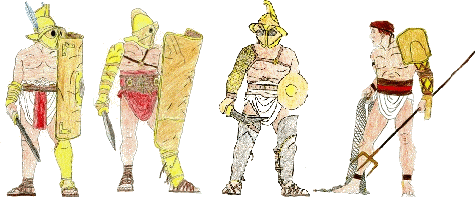 |
| Information |
| Although any sort of weapon and combination of armor is allowed within the Arena of Haven there are some traditional styles. gladiator: The word gladiator comes from the Latin for swordsman, from gladius, sword. Samnite: He used a large oblong shield (scutum) and wore a metal or boiled leather greave (ocrea) on his left leg. He also wore a visored helmet (galea) with a large crest and plume and was armed with a sword (gladius). Thracian: The Thracian wore ocrea on both legs and carried a small square shield. On his head he wore either a full visored helmet or an open faced helmet with a wide brim. His weapon was a curved scimitar (sica) or the Thracian sword which had an angled bend in the blade. Secutor: The Secutor took his name from the term for "pursuer" and was an offspring of the Samnite. He fought virtually naked and carried a large oval or rectangular shield as well as wearing an ocrea on his left leg. Typically he was bald and wore a round or high-visored helmet. Often his arms were protected by leather bands at the elbow and wrists (manicae). He was traditionally armed with a sword although occasionally he fought with a dagger. Retiarius: A lightly armoured gladiator that symbolised the fisherman the Retiarius wore only a loin cloth (subligaculum) and a metal shoulder-piece (galerus) on the left arm. He fought bare headed and carried a net (iaculum) with which he attempted to ensnare his opponents. His weapons included a dagger and a trident or tunny-fish harpoon (fascina).. |
 |
| Aquila: (Ah-KWEE-lah) n. the standard of the Empyreal Praetorian Guard. Their insignia is an eagle with its wings outspread, and it is often depicted on either breastplates or shields. Due to a common mistake, the "aquila," or eagle, is often confused with a hawk, thus leading to the nickname of the Praetorian Guard. arbalist: (ARR-bah-list) n. a military weapon resembling the crossbow, with a steel bow used to throw balls, stones, or quarrels. Originally developed by the Varati, this weapon has since been adopted by the Empyreans. assegai: (ASS-ah-gie) n. a slender, hardwood spear or light javelin, usually tipped with iron or stone and used by the Sylvans. atlatl: (at-LAT-l) n. a device for throwing a spear or dart which consists of a rod or board with a projection (hook or thong) at rear end to hold weapon in place until released. Used chiefly by the Sylvans. baldric: (BALL-drik) n. an ornamented belt that loops around the waist and over the right shoulder and often used to suspend a sword or dagger. Worn by members of the Empyreal Praetorian guard, its style serves to indicate the rank of the wearer. Also called a "cingulum." bracers: (BRAY-sers) n. pl. bands of leather wrapped around the forearm to protect the arm during archery or fencing. brigandine: (BRIG-ahn-deen) n. a coat of mail consisting of thin, joined scales of plate fastened with leather or cloth to make the coat flexible. Used by the Varati. broadsword: (BROD-sord) n. a Varati sword with a broad blade used for cutting rather than thrusting. buckler: (BUK-ler) n. a small round shield, worn on the arm or held in one hand. It varies in size and form, fashioned from wicker, wood, thick leather, or metal. buskins: (BUS-kins) n. pl. laced leather boots reaching halfway or more to the knee. caestus: (SES-tus) (pl. caesta) n. a hand covering of leather bands, often loaded with lead or iron, and used by Empyreans in hand-to-hand combat. corium: (KOR-ee-um) n. body armor composed of scales or small plates of leather, worn into combat by members of the Empyrean Praetorian guard. cuirass: (kwi-RAS) n. breastplate of leather 2. n. close-fitting armor for protecting the breast and back. dirk: (derk) n. a long, straight-bladed dagger. |
| falcare: (fahl-KARE) n. a broad-bladed, slightly curved sword used by the Varati. gladius: (GLAD-ee-us) n. an Empyreal shortsword used by members of the Praetorian Guard. greaves: (greeves) n. pl. armor for the legs from the ankle to the knee; often made of tough leather or light metal. helm: (helm) n. a protective covering for the head, originally made of leather, later strengthened with bronze. javelin: (JAV-eh-lin) n. a light spear with a slender shaft of wood or metal; used by Empyreans and Sylvans. keris: (KARE-iss) n. a Varati ceremonial dagger with a wavy, serpentine blade. lorica: (lor-EE-ka) n. Empyreal cuirass of leather or (rarely) metal. Lorica segmentata: joined plate armor. morion: (MOR-ee-ahn) n. a high-crested helmet with no visor, more for ceremonial purposes than combat. pilum: (PI-loom) n. a shafted spear with a heavy wooden grip that is designed to be thrown at a foe. When the metal contacts a point, it is designed to bend and weigh it down. magna pilum: (MAG-na PI-loom) n. similar to the pilum, it is harder, longer and designed for jabbing from a height. pteryges: (TERR-ih-jeez) n. the leather straps which depend from the waist to the knees as a "skirt," typically worn over a tunic beneath, and favored by Empyreal soldiers in the Praetorian Guard. pugio: (POO-jee-oh) n. a dagger with a narrow blade, often used by Empyreans. quarrel: (KWAR-el) n. a square-headed missile or arrow used in crossbows. quarterstaff: (KWAR-ter-staf) n. a stout, iron-tipped staff, 6 to 8 feet in length; held in one hand at the middle and the other hand midway between the middle and end. Most often used by Sylvans. shiv: (shiv) n. city-slang for knife. skean: (skeen) n. city-slang for a dagger or dirk. yataghan: (YAT-ah-gahn) n. a short saber with a double-curved blade (like a mild 'S' shape), about two feet long, including a handle with a cross-guard. Varati in origin. |